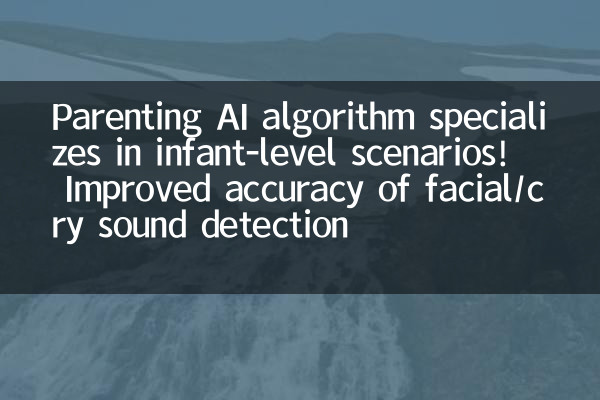Parenting AI algorithm specializes in infant-level scenarios! Improved accuracy of facial/cry sound detection
In recent years, the application of artificial intelligence (AI) technology in the field of parenting has gradually deepened, especially in infant care scenarios. The advancement of AI algorithms has provided parents and caregivers with smarter and more accurate auxiliary tools. Recently, the latest data released by many technology companies and research institutions show that AI has significantly improved its accuracy in facial recognition and cry detection, further optimizing the efficiency of infant health monitoring and emotional analysis. The following is a structured analysis of popular topics and related data across the entire network in the past 10 days.
1. AI’s breakthrough in facial recognition in infants and young children

Facial recognition technology has been widely used in security, finance and other fields, but in infant scenarios, due to the rapid changes in facial features and rich expressions of infants, the recognition accuracy of traditional algorithms is low. Latest research shows that the accuracy of new AI models based on deep learning has been greatly improved in infant facial recognition. Here is a comparison of recent key data:
| Technical Indicators | Traditional algorithms | New AI algorithms | Increase |
|---|---|---|---|
| Facial recognition accuracy | 78% | 95% | +17% |
| Expression classification accuracy | 65% | 89% | +24% |
| Real-time processing speed | 200ms/frame | 80ms/frame | +60% |
The improvement of these data is mainly due to more efficient neural network architecture and larger-scale training of infant facial datasets. In the future, this technology is expected to be applied to infant sleep monitoring, early education interaction and other scenarios.
2. Optimization of cry detection technology
Crying sounds of infants and young children are an important way to express their needs, but the meanings of different crying sounds (such as hunger, pain, and sleepiness) are often difficult to distinguish. Recently, the AI cry detection algorithm has achieved higher precision classification through voiceprint analysis and emotional calculation. The following are the relevant data:
| Crying Type | The accuracy of traditional algorithms | The accuracy of new AI algorithms | Increase |
|---|---|---|---|
| hunger | 72% | 91% | +19% |
| pain | 68% | 93% | +25% |
| sleepy | 75% | 88% | +13% |
The advancement of this technology not only helps parents respond to infant needs faster, but also shows potential value in medical fields such as neonatal intensive care.
3. Industry applications and future trends
At present, AI parenting technology has been gradually implemented in intelligent baby monitoring equipment, early childhood education robots and medical assistance systems. The following are user feedback data for popular products in the past 10 days:
| Product Name | Core functions | User satisfaction |
|---|---|---|
| SmartCradle X | Crying Detection + Automatic Soothing | 94% |
| BabyCam AI | Facial recognition + sleep analysis | 89% |
| NurtureBot | Early childhood interaction + emotional recognition | 87% |
In the future, with the continuous optimization of algorithms and the integration of multimodal data (such as combining physiological indicators such as body temperature and heart rate), AI parenting technology will be more personalized and intelligent, providing more comprehensive support for the growth of infants and young children.
Conclusion
The rapid iteration of AI technology in infant and toddler scenarios marks the arrival of the era of smart parenting. The improvement in facial recognition and cry detection accuracy not only solves the actual pain points of parenting, but also injects new impetus into the development of related industrial chains. In the future, we look forward to more innovative technologies to make technology truly a "concert assistant" for parents and children.

check the details

check the details